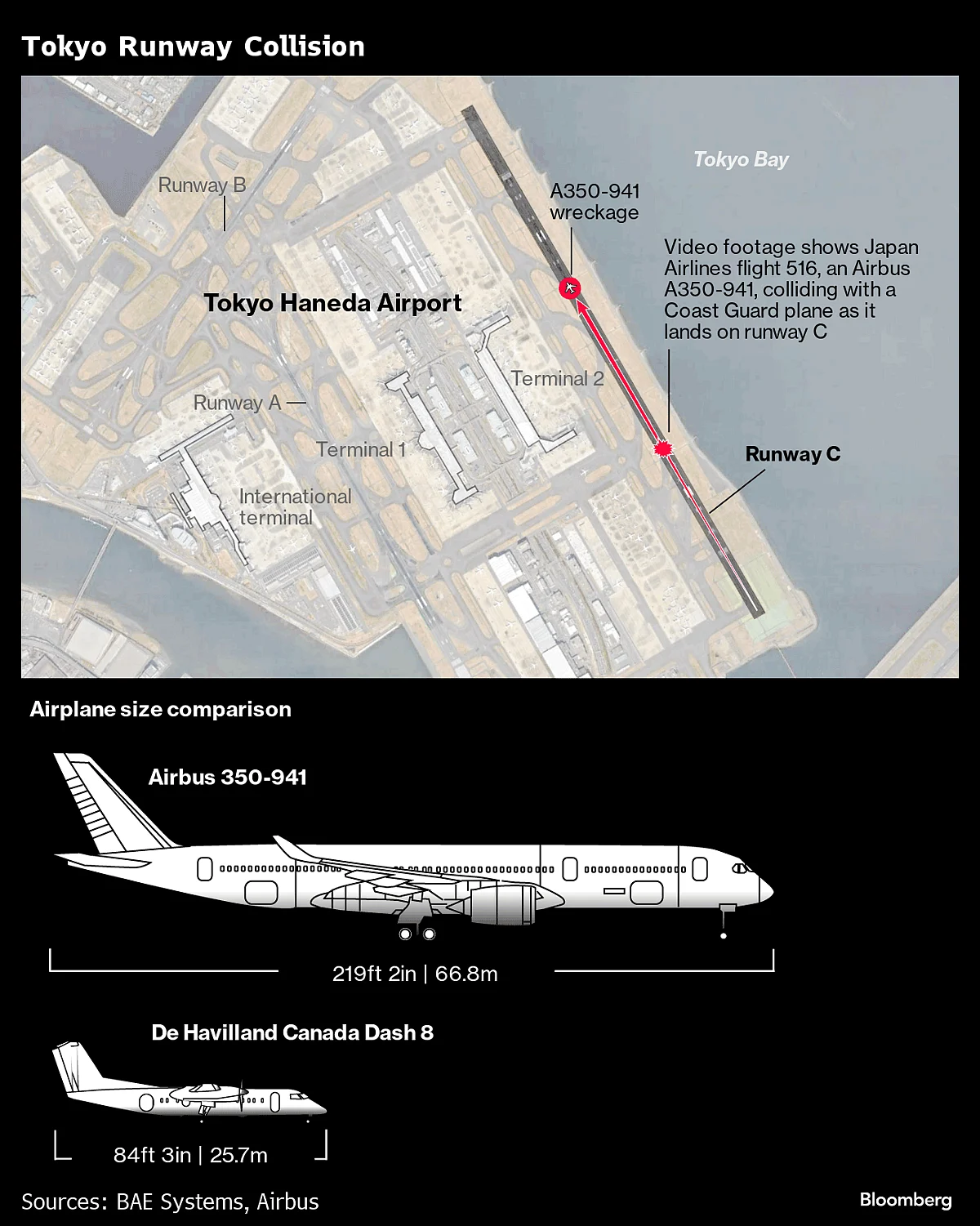Japan Airlines Flight Was Cleared To Land Before Fiery Tokyo Collision
At 5:43 p.m. local time, control-tower staff told pilots of the Airbus SE A350-900 jet to continue their approach into Haneda.

(Bloomberg) -- As Japan Airlines Co. Flight 516 approached Tokyo’s Haneda Airport late on Tuesday afternoon, all signs pointed to an uneventful conclusion to the routine one-and-a-half hour journey from Sapporo in northern Japan.
At 5:43 p.m. local time, control-tower staff told pilots of the Airbus SE A350-900 jet to continue their approach into Haneda. A minute-and-a-half later, the flight was given clearance to land, according to audio posted on LiveATC.net, which tracks airport communications.
Less than three minutes after that, the jetliner with 379 people aboard was in flames, having struck a much smaller De Havilland Canada Dash 8 operated by the Japanese coast guard just as it touched down.
“We have a fire on runway 34R,” an unidentified speaker said.

The collision on 34R, also known as Runway C, set off a fireball at the point of impact, with video of the incident showing the JAL widebody bursting into flames as it skidded down the runway to a stop. Quick rescue work allowed all 367 passengers and 12 crew members to escape, even as smoke filled the A350’s cabin.
Five of the six crew on the coast guard plane that was preparing to deliver emergency aid to victims of the Jan. 1 earthquake in northwestern Japan died. The victims were co-pilot Nobuyuki Tahara, 41; radio operator Yoshiki Ishida, 27; radar operator Wataru Tatewaki, 39; and mechanics Makoto Uno, 47, and 56-year-old Shigeaki Kato, the Coast Guard said in a statement. The pilot, 39-year-old Genki Miyamoto, survived.
At a press conference Tuesday night, JAL officials said they believed Flight 516 had permission to land, though they weren’t yet drawing conclusions. It wasn’t clear whether the coast guard plane was also given clearance to be on the runway — instructions were garbled on the ATC recording.
Human error on the part of the airline, the coast guard or the controllers is possible, said Kotaro Toriumi, a Japanese travel and aviation analyst.
Disruptions continue into Wednesday, with dozens of flights canceled, according to Haneda Airport’s website. A livestream of the airport showed the charred remains of one of the planes strewn across the runway.
Japanese transport ministry and coast guard officials said Tuesday evening they were investigating the cause of the incident and how it could have been prevented. The ministry’s transport safety board will seek to determine whether any miscommunication occurred in the air traffic control operation.

Airbus said it will provide technical assistance to French and Japanese authorities investigating the crash, while Japanese Prime Minister Fumio Kishida, already contending with the major new year earthquake, ordered aid to the possible victims.
JL516 took off from New Chitose airport near Sapporo at 4:27 p.m. local time, according to FlightRadar24. The two-year-old A350 landed at 5:47 p.m. and was quickly thrown into an emergency.
Footage posted on social media by fleeing passengers showed emergency slides deployed at exits on both sides of the aircraft, which could be seen tilted forward with a collapsed front landing gear, flames licking its windows and smoke billowing over the fuselage as fire services battled the blaze.
Later footage showed the entire plane engulfed in a massive blaze, damaging the aircraft beyond repair. NHK said that at least 17 people on the JAL flight were injured.
Modern aircraft need to be able to completely evacuate in no more than 90 seconds, using only half the number of their available emergency slides. To gain certification, manufacturers conduct drills with fully loaded aircraft under simulated chaotic conditions. Even the giant Airbus A380 has managed to empty out in that time window, with a few seconds to spare.
The aircraft is the first A350 hull to be destroyed by an accident. Japan Airlines operates a fleet of 16 A350-900s, seating either 369 or 391 passengers in a so-called high density domestic configuration. The carrier has been flying the type since 2019.
On-ground impacts between aircraft are rare and damage is typically minor because collisions tend to happen during slower taxiing. The worst disaster in aviation history, however, happened during a ground collision in 1977, when two Boeing 747 jumbo jets collided on the runway at Los Rodeos Airport on the Spanish island of Tenerife, killing 583 people.
Haneda Airport hasn’t suffered a fatal aircraft accident since February 1982, when a McDonnell Douglas operated by JAL crashed near the airfield into Tokyo Bay, resulting in the death of 24 of the 174 people on board, according to the Aviation Safety Network.
Unaffected runways at Haneda were re-opened late on Tuesday, while some incoming flights were diverted to other airports.
“We aim to revive flight operations at Haneda as soon as possible” Tetsuo Saito, minister of land, infrastructure, transport and tourism, said Tuesday evening at a briefing.
--With assistance from Jon Herskovitz, Dave Merrill, Shoko Oda, Brian Fowler, Masatsugu Horie, Isabel Reynolds, Anthony Palazzo and Go Onomitsu.
(Adds victims names in sixth paragraph. An earlier version of this story corrected the name of the transport minister.)
More stories like this are available on bloomberg.com
©2024 Bloomberg L.P.